Oral presentations and abstracts
The late stage formation of planetary systems has a crucial impact on the final system configuration. A deep understanding of the architecture of both RV-detected systems and transit-detected systems is particularly important to get a unified vision of planetary system formation.
In this session we address the question of the formation, dynamical evolution and stability of planetary systems in a broad sense, including the effects of planet-disc interactions, resonances, high eccentricity migration, binary stars,...
Session assets
Observations of the Rossiter-McLaughlin effect have revealed that the orbits of many exoplanets are misaligned with respect to the stellar rotation axis. Various scenarios have been proposed that associate the orbit obliquity either with multi-body interactions or dynamical processes in the disc during the planet formation process. In this talk, I will present how infrared interferometry allows us to study the origin of the planet obliquity:
In the first part of the talk I will present observations that reveal the recently-posted disc tearing effect, where the gravitational torque of companions on misaligned orbits can tear the disc apart into distinct rings that precess independently around the central objects. We imaged the triple system GW Orionis using VLTI, CHARA, ALMA, SPHERE, and GPI and discover three rings in thermal light and an asymmetric structure with radial shadows in scattered light. The inner-most ring is eccentric (e=0.3; 43 au radius) and strongly misaligned both with respect to the orbital planes and with respect to the outer disc. Modelling the scattered light signatures and the shape of the shadows cast by the misaligned ring allows us derive the shape and 3-dimensional orientation of the disc surface, revealing that the disc is strongly warped and breaks at a radius of about 50 au. Based on the measured triple star orbits and disc properties, we conducted smoothed particle hydrodynamic simulations which show that the system is susceptible to the disc tearing effect. The ring offers suitable conditions for planet formation, providing a mechanism for forming wide-separation planets on highly oblique orbits. Our results imply that there may exist a significant, yet undiscovered population of long-period planets on highly oblique orbits that has formed around misaligned multiple systems.
In the second part I will show how infrared interferometry can be used to search for this predicted population of wide-separation planets on oblique orbits, probing a highly complementary regime to the parameter space accessible with the Rossiter-McLaughlin effect. I will present the first study where the spin-orbit alignment has been measured for a directly-imaged exoplanet, namely on Beta Pictoris b. We used VLTI/GRAVITY spectro-interferometry with an astrometric accuracy of 1 microarcsecond to measure the photocenter displacement associated with the stellar rotation. Taking inclination constraints from astroseismology into account, we constrain the 3-dimensional orientation of the stellar spin axis and find that Beta Pic b orbits its host star on a prograde orbit with a small obliquity angle.
I will conclude by offering a near-term perspective on how infrared interferometry with the proposed BIFROST beam-combination instrument could advance our understanding of the planet formation process and of the early dynamical evolution of exoplanetary systems.
How to cite: Kraus, S.: The origin of the obliquity in planetary systems studied with infrared interferometry, Europlanet Science Congress 2020, online, 21 Sep–9 Oct 2020, EPSC2020-61, https://doi.org/10.5194/epsc2020-61, 2020.
Stars born in clusters are subject to frequent stellar flybys and so are their planets. The influence of an encounter reaches beyond the brief flyby itself in that the mutual forcing between the planets will continue to shape the planetary system in the long term and in a way that is impossible without the encounter in the first place. As a consequence, different planetary systems of different orbital scales and mass ranges behave differently as a result of the encounters.
Here we study the encounters between two planetary systems where each star has its own planets using N-body simulations. Besides the immediate effect of the encounter, we have also propagated the systems post-encounter for up to 10^8 yr. See Figure 1 for an illustration.
We find that immediately during the encounter, a planet can be ejected from its original host star. Here, the interplanetary interactions are negligible and a planet’s stellar-centric distance is a key factor. Only encounters closer than a few times that distance can cause strong disturbances, e.g., to eject the planet or to break the resonance in multi-planet systems. This means that close-in (<1 au) planets are, to a large extent, immune to such flybys and so are the orbital resonances among these planets because encounters as close as a few au are very rare. Wide-orbit planets, in contrast, are especially susceptible. Take the HR 8799 system for example; the odds for an encounter at 100s of au to disrupt the systems are still about 50%. Hence, wide-orbit multi-planet systems probably do not originate in dense clusters.
Then, during the long-term post-encounter evolution, the interplanetary forcing takes control and the planets’ masses, intertwined with orbital spacing, play an important role. In general, the larger the angular momentum deficit (AMD) a system acquires immediately during the encounter, the more likely and the earlier it becomes unstable in this later phase. The eccentricity change during the encounter is not related to the planetary mass. Hence, if a multi-planet system has the more massive planets farther-out, this system gains more AMD during the encounter and is more prone to later instability than one with massive planets closer-in.
In unstable planetary systems, usually the less massive planets are lost; in systems of no mass hierarchy, all planets are equally vulnerable. Both interplanetary scattering and a stellar encounter can cause the loss of a planet in a multi-planetary system (Figure 2). We find that the encounters are in general gentler in the sense that the outer planet can be instantly ejected without disturbing the inners much, leading to a lower eccentricity distribution for the survivors. On the contrary, interplanetary scattering gives rise to significantly more excited systems.
During the encounter, a planet can also be captured by the intruder. The captured planets intensify the post-encounter instability (Figure 3) of the planetary system of the intruder and they themselves are often lost. Otherwise, a massive captured planet on a wide orbit can tilt the inner tightly-packed original planets via the Kozai-Lidov mechanism. This creates a ``cold'' system with small eccentricities and low mutual-inclinations which as a whole highly is inclined with respect to the equator of the central star. Finally, the captured planets usually acquire highly-eccentric and -inclined orbits and half are retrograde.
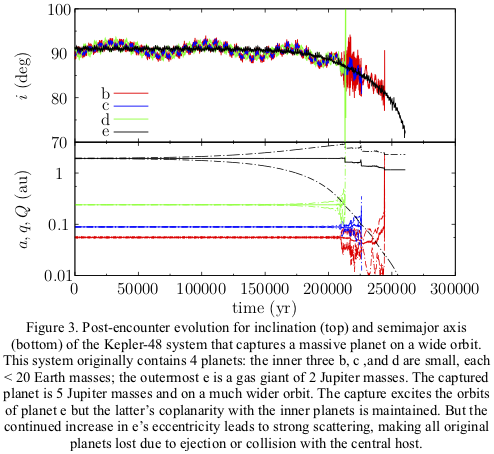
Full details can be found in Li, Mustill & Davies (2019, MNRAS, 488, 1366; 2020, MNRAS in press, doi: 10.1093/mnras/staa1622).
The authors acknowledge financial support from Knut and Alice Wallenberg Foundation (2014.0017 and 2012.0150) and from Vetenskapsrådet (2017-04945). The authors also thank the Royal Physiographic Society of Lund.
How to cite: Li, D., Mustill, A., and Davies, M.: Flyby encounters between two planetary systems, Europlanet Science Congress 2020, online, 21 Sep–9 Oct 2020, EPSC2020-228, https://doi.org/10.5194/epsc2020-228, 2020.
Robust evidence of an ice giant planet shedding its atmosphere around the white dwarf WD J0914+1914 represents a milestone in exoplanetary science, allowing us to finally supplement our knowledge of white dwarf debris discs, minor planets and metal pollution with the presence of a major planet.
Here, I discuss the possible dynamical origins of this planet, WD J0914+1914 b. The very young cooling age of the host white dwarf (13 Myr) combined with the currently estimated planet-star separation of about 0.07 au imposes particularly intriguing and restrictive coupled constraints on its current orbit and its tidal dissipation characteristics. The planet must have been scattered from a distance of at least a few au to its current location, requiring the current or former presence of at least one more major planet in the system in the absence of a hidden binary companion. I show that WD J0914+1914 b could not have subsequently shrunk its orbit through chaotic f-mode tidal excitation (characteristic of such highly eccentric orbits) unless the planet was or is highly inflated and possibly had partially thermally self-disrupted from mode-based energy release. I also demonstrate that if the planet is currently assumed to reside on a near-circular orbit at 0.07 au, then non-chaotic equilibrium tides impose unrealistic values for the planet's tidal quality factor. I conclude that WD J0914+1914 b either (i) actually resides interior to 0.07 au, (ii) resembles a disrupted `Super-Puff' whose remains reside on a circular orbit, or (iii) resembles a larger or denser ice giant on a currently eccentric orbit. Distinguishing these three possibilities strongly motivates follow-up observations.
I will also analyse the prospects for exterior extant rocky asteroids, boulders, cobbles, and pebbles to radiatively drift inward past the planet due to the relatively high luminosity of this particularly young white dwarf, and I will place stability bounds on the gas disc formed from the planet's evaporated atmosphere.
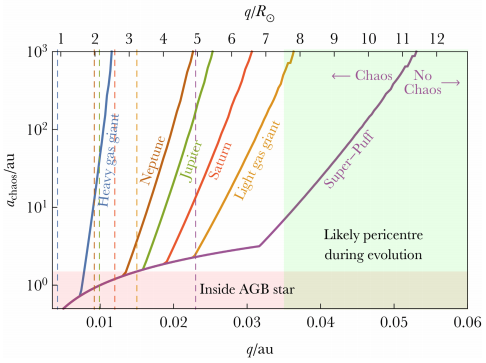
Caption: Demonstration that WD J0914+1914 b was very unlikely to have experienced high-eccentricity chaotic tidal evolution unless the planet is or was a highly inflated Super-Puff. The solid curves represent the minimum initial semimajor axes (y-axis) for which different types of planets would have experienced chaotic tidal evolution around the white dwarf for given orbital pericentres (x-axes). The vertical dashed lines are representative white dwarf tidal disruption radii for each type of planet, ordered from left to right in the same way as the solid curves. Because Super-Puffs are particularly vunerable to self-disruption through chaotic tides, current observations may be of a partially or fully disrupted ice giant.
How to cite: Veras, D. and Fuller, J.: The dynamical history and current orbital constraints of a milestone ice giant planet orbiting a white dwarf, Europlanet Science Congress 2020, online, 21 Sep–9 Oct 2020, EPSC2020-239, https://doi.org/10.5194/epsc2020-239, 2020.
Introduction
Understanding planetary formation is principally a theoretical task. However, the relevant processes that occur during this phase are poorly constrained, from how solids grow from dust to Earth-like planets or cores of giant planets, to how planetary migration affects the architecture of the systems. To determine if these model represent the reality, we need to compare them with observations.
Planetary formation and evolution models have many unknowns. As individual systems of extrasolar planets provide a low number of data, the comparison has to be performed at the population level to provide meaningful constraints on the models. Here, we present a framework for this purpose. It encompasses the Bern global model of planetary formation and evolution, the distribution of protoplanetary disc properties to perform planetary population synthesis, and the comparison of the synthetic planetary population with the combined Coralie-HARPS GTO survey [1].
Methodology
The Generation III Bern model is a global model of planetary formation and evolution [2]. It tracks the relevant processes that occur during the formation and evolution of planetary systems.
The formation stage tracks the evolution of a viscous accretion disc, whose viscosity is provided by the standard α-parametrisation. Solids are represented by planetesimals, whose dynamical state is given by the drag from the gas and the stirring from the other planetesimals and the growing protoplanets.
A fixed number of protoplanetary seeds (1-100) are placed at the beginning of the formation. These protoplanets accrete planetesimals from the disc and cores of other protoplanets core upon collision. The gaseous envelope's structure is retrieved by solving the standard 1D internal structure equations. They allow to retrieve the envelope mass and the gas accretion rate (in the attached phase), or the radius (in the detached phase). The formation stages also include gas-driven planetary migration and the gravitational interactions between the protoplanets by means on an N-body.
Once the formation stage is finished, the model transitions to the evolutionary phase, where planets are followed individually to 10 Gyr. The planetary evolution model includes thermodynamical evolution (cooling and contraction), atmospheric escape, bloating, and migration due to tides raised on the star.
This model is used to compute a synthetic population of planetary systems. Observational data are used to constrain the initial conditions of the protoplanetary disc: their mass, metallicities (i.e. dust to gas ratio), radial extend and life times [3]. We selected the same number of systems as in the combined Coralie-HARPS GTO survey sample (822) so that we can also compare the absolute number of planets. We assume that each system is observed from a random direction to compute the inclination of the orbit of each planet. This enables to compute the effective mass Msin(i) of the planet. The detection probability of each planet is computed from completeness curves of the survey [1].
Results
In the synthetic population, we detect 317 planets while 161 planets were detected in the actual combined Coralie-HARPS sample. Hence, the model forms about twice the number of planets that are observed. Nevertheless, the multiplicity (i.e. the mean number of planets per system) is similar in the two populations: The 317 synthetic planets are found around 204 stars, while the actually observed 161 planets are distributed in 102 systems. this indicates that the system architectures are more similar than the absolute frequencies.
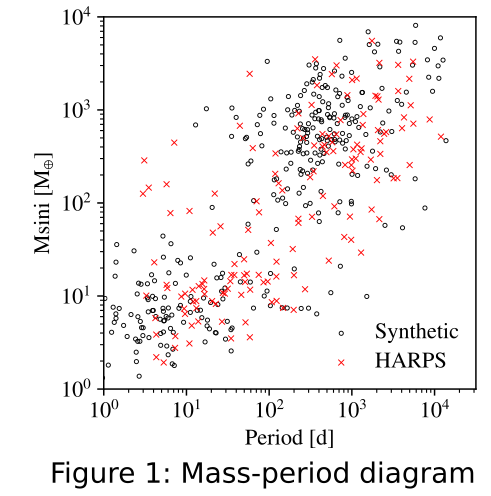
The mass-period diagram (Figure 1) shows the planets in the synthetic population (black circles) and the ones found in the Coralie-HARPS survey (red circles). The two populations have similar clusters on super Earths at about 10 days and giant planets at about 1000 days. However, the synthetic planets are more concentrated in these regions and there are relatively few synthetic planets in between or hot-Jupiters.
The mass histogram (Figure 2) shows for the synthetic population (black), the observed sample (red), and the synthetic population scaled so that it has the same total value as the observed sample (blue). It reveals that both super-Earths and giant are too numerous in the synthetic population. However, there is disproportionately more giant planets coupled to a lack of Saturn-mass planets in the synthetic population.
Discussion
The whole framework provides a powerful framework to quantitatively constrain models of planetary formation and evolution. We obtained that our model [2] is too efficient by a factor two in absolute terms, although the mean multiplicity is similar in the two samples (synthetic and observed). This excess of planets is caused by an overabundance of giant planets coupled with a relative lack of planets at intermediate masses (20 to 200 MEarth), which suggest that the gas accretion rate in our model is too high.
It is possible to statistically compare many more quantities, such as eccentricity or stellar parameter like its metallicity to see if the metallicity effect (e.g., [4]) is retrieved in the synthetic population. Also, different system architectures or (anti)correlated occurrence of different planet types can be compared. We will present these results during the conference.
In case the synthetic population does not retrieve the trends of the observed sample, it means that the formation model needs to be modified. Once the observed population can be satisfactorily reproduced, we can 1) determine how the physical processes work to form exoplanetary systems and 2) make predictions about the underlying population.
Our global model predicts the quantities necessary for comparison with different observational techniques, such as radius for transits and luminosity for direct imaging. We have parallel efforts to perform comparison with other surveys, such as Kepler [5,6] or SPHERE [7].
References
[1] Mayor, M. et al. arXiv:1109.2497 (2011)
[2] Emsenhuber, A., Mordasini, C., Burn, R., Alibert, Y., Benz, W., and Asphaug, E.: NGPPS I. A&A (subm.)
[3] Emsenhuber, A., Mordasini, C., Burn, R., Alibert, Y., Benz, W., and Asphaug, E.: NGPPS II. A&A (in prep.)
[4] Adibekyan, V. Geosciences, 9, 105 (2019).
[5] Mulders, G. D. et al. ApJ, 887, 157 (2019).
[6] Mishra, L. et al. EPSC abstract (2020)
[7] Vigan, A. et al. A&A (subm.)
How to cite: Emsenhuber, A., Mordasini, C., Mayor, M., Marmier, M., Udry, S., Mishra, L., Alibert, Y., Benz, W., and Asphaug, E.: The New Generation Planetary Population Synthesis (NGPPS): Comparison with the HARPS GTO survey, Europlanet Science Congress 2020, online, 21 Sep–9 Oct 2020, EPSC2020-339, https://doi.org/10.5194/epsc2020-339, 2020.
About half of the Sun-like stars are part of multiple-star systems. To date more than 100 planets are known moving around one stellar component of a binary star (S-type planets), with diverse eccentricities. These discoveries raise the question of their formation and long-term evolution, since the stellar companion can strongly affect the planet formation process. Here we study the dynamical influence of a wide binary companion on the (Type-II) migration of a single giant planet in the protoplanetary disk. Using a modified version of an N-body integrator adapted for binary star systems and adopting eccentricity and inclination damping formulae (derived from hydrodynamical simulations) to properly model the influence of the disk, we carried out more than 3500 numerical simulations with different initial configurations and study the dynamics of the systems up to 100 Myr. Particular attention is paid to the Lidov-Kozai resonance whose role is determinant for the evolution of the giant planet, although initially embedded in the disk, when the stellar companion is highly inclined. We highlight the high probability for the planet of experiencing, during the disk phase, a scattering event or an ejection due to the presence of the binary companion. We also show that a capture of the migrating planet in the Lidov-Kozai resonance is far from being automatic even when the binary companion is highly inclined, since only 10% of the systems actually end up in the resonance. Nevertheless, using a simplified quadrupolar hamiltonian approach, we point out that, for highly inclined binary companions, the dynamical evolutions are strongly affected by the Lidov-Kozai resonance islands, which create the pile-ups observed around – but not centred on – the pericenter values of 90° and 270° in the final distribution of the giant planets. The influence of the self-gravity of the disk on the previous results is finally discussed.
How to cite: Roisin, A. and Libert, A.-S.: Dynamical influence of a wide binary companion on giant planet migration, Europlanet Science Congress 2020, online, 21 Sep–9 Oct 2020, EPSC2020-372, https://doi.org/10.5194/epsc2020-372, 2020.
The characterization of the interplay between the inner and outer parts of planetary systems has long been impractical due to the separated detection ranges of the corresponding observation techniques. However, this gap is closing thanks to the technical improvements of the instruments and the longer observational baselines, and statistical insights are already within reach on the impact of cold Jupiters on super Earths. In this talk, I would like to present a theoretical study on the influence of an external giant planet misaligned with inner resonant planets, within the circular restricted problem. The behavior of the system depends on the relative strength between the coupling of the planets and the perturbations from the outer body. We demonstrated that mean-motion resonance strengthens the inner coupling and is very resilient to the perturbation, surviving periodic relative inclination increases of tens of degrees between the inner planets. This study has applications for the indirect detection of exoplanets, as well as the understanding of their formation and evolution, in particular the role of mean-motion resonance and relative inclinations.
How to cite: Rodet, L. and Lai, D.: Hiding resonant planets behind a big friend, Europlanet Science Congress 2020, online, 21 Sep–9 Oct 2020, EPSC2020-466, https://doi.org/10.5194/epsc2020-466, 2020.
Super-Earths are by far the most dominant type of exoplanet, yet their formation is
still not well understood. In particular, planet formation models predict that many
of them should have accreted enough gas to become gas giants. Here we examine the
role of the protoplanetary disk in the cooling and contraction of the protoplanetary
envelope. In particular, we investigate the effects of 1) the thermal state of the disk as
set by the relative size of heating by accretion or irradiation, and whether its energy is
transported by radiation or convection, and 2) advection of entropy into the outer envelope by disk flows that penetrate the Hill sphere, as found in 3D global simulations.
We find that, at 0.1 AU, the envelope quickly becomes fully radiative, nearly isothermal, and thus cannot cool down, stalling gas accretion. This
effect is significantly more pronounced in convective disks, leading to envelope mass or-
ders of magnitude lower. Entropy advection at 0.1 AU in either radiative or convective
disks could therefore explain why super-Earths failed to undergo runaway accretion.
Ali-Dib, Cumming, & Lin (MNRAS 2020)
How to cite: Ali-Dib, M., Cumming, A., and Lin, D.: Stopping Super-Earths from growing into Jupiters, Europlanet Science Congress 2020, online, 21 Sep–9 Oct 2020, EPSC2020-506, https://doi.org/10.5194/epsc2020-506, 2020.
With the discovery that many exoplanetary systems harbor several closely-spaced planets, questions relating to their stability have become relevant. We have integrated closely-spaced planetary systems, with the goal of quantifying their stability times over very long time scales (up to ten billion years). Each of our systems started out with five identical, Earth-mass planets orbiting a solar-mass star, with orbits being spaced as a geometric sequence, and initial eccentricities up to e = 0.05 given to either one, or all, planets. For all planets eccentric, we ran several sets of simulations: one where the initial periapses were aligned, and others with randomized (either over all azimuths or a restricted range) initial periapse angles. In all cases, the trend in system lifetimes follows a log-linear relationship between time to close encounter and initial separation (with differing slopes). We confirmed this relationship up to initial orbit separations of approximately 10 Hill radii for small eccentricity (e=0.01), and up approximately 13 Hill radii for the largest considered eccentricity (e=0.05). to On a more granular level, we find substantial differences in life times at resonances for low eccentricity systems, but those differences are reduced in magnitude for higher eccentricities and/or randomized periapses. For systems with just one planet eccentric, the time to close encounter depends on which planet starts out eccentric: an eccentric intermediate planet typically shortens the time to close encounter compared to the same value of eccentricity given to either the inner or outer planet. If all planets start out with the same eccentricity and aligned periapses, stability is restored — such systems are on average only slightly less stable than initially circular ones. Angular momentum deficit does not appear to influence stability times, suggesting that mean motion resonances play the dominant role over secular resonances. This was checked by comparing systems with identical total angular momentum deficit for the same initial separations. We chose to compare systems with innermost planet eccentric with their corresponding systems with outermost planet eccentric (i.e., identical AMD, implying smaller initial eccentricity). Survival times were consistent with merely initial separation and eccentricity playing the dominant roles: AMD does not appear to influence the behavior of those systems. Finally, survival probabilities are calculated for any given initial separation and given time for systems where all five planets start out with eccentricity 0.05 and randomized periapses. Here we considered batches with periapses randomly chosen within 45, 90, 135, 180, and 360 degrees, respectively. A broader choice of periapse angles is inversely correlated with the appearance of clear peaks and troughs in survival times. For periapse angles chosen within the full circle, we plot probabilities of survival at some fixed given times, as a function of initial separation. We show that their trends exhibit significantly different behaviors depending on initial system eccentricity.
How to cite: Gratia, P.: Eccentricity and the Lifetimes of Closely-Spaced Five-Planet Systems, Europlanet Science Congress 2020, online, 21 Sep–9 Oct 2020, EPSC2020-508, https://doi.org/10.5194/epsc2020-508, 2020.
The Kepler mission revealed thousands of exoplanet candidates, providing key insights into the distributions and demographics of planetary systems. Many of these planets are in multiple-transiting planet systems, which yield additional information about the correlations within planetary systems and their architectures. However, these properties are shrouded by complex detection biases, which must be properly accounted for in order to disentangle the intrinsic system architectures from the observational biases.
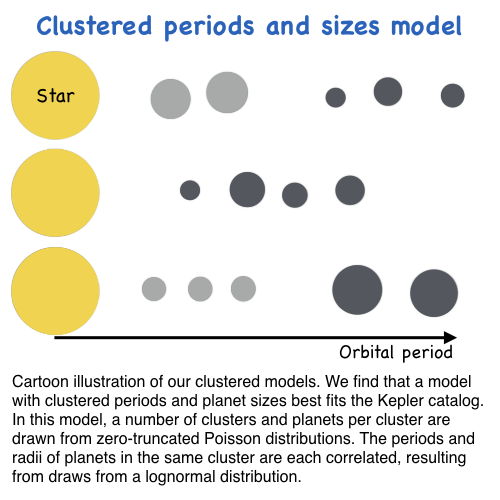
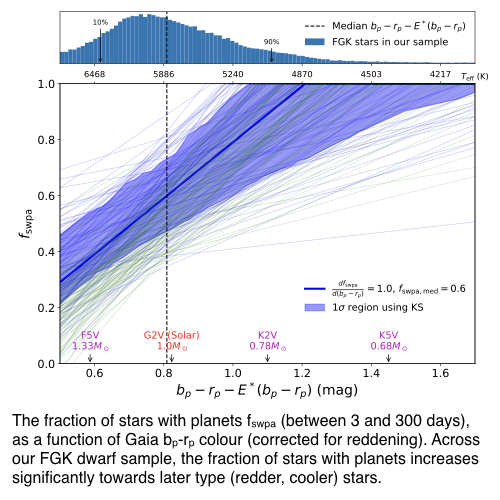
In He, Ford, & Ragozzine (2019, 2020), we developed an advanced forward model (SysSim) to infer the intrinsic distributions of planetary systems around FGK dwarfs, by constructing parametric models for drawing planetary systems, simulating the Kepler detection efficiency to produce synthetic observed catalogs, and comparing these catalogs to the Kepler catalog. We show that planetary systems around FGK dwarfs are clustered in periods and in sizes, as evidenced by fitting to the observed distributions of multiplicities, period ratios, and transit depth ratios. We also find that the fraction of stars with planets (with Rp > 0.5 R⊕ and 3d < P < 300d) increases significantly towards later type (cooler) stars, rising by over a factor of two from early F to mid K dwarfs. The observed multiplicity distribution can be well matched by two populations consisting of a low and a high mutual inclination component (a Kepler dichotomy).
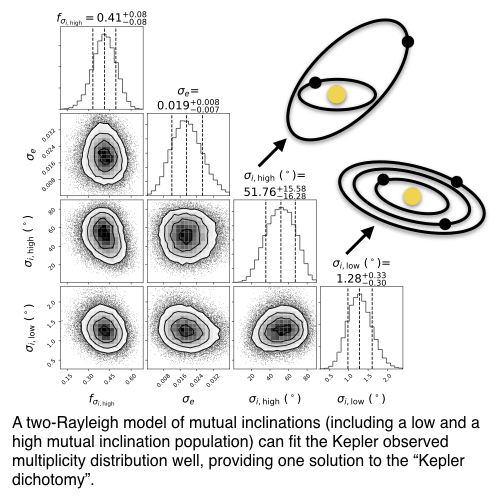
Here, I will also present a new model to show that a broad distribution of eccentricities and mutual inclinations arising from systems at the angular momentum deficit (AMD) stability limit can also reproduce the observed population. The AMD stability limit provides a dynamically motivated view of orbital architectures and serves to constrain the high mutual inclination systems. In our new model, we distribute the maximum AMD of each multi-planet system amongst the planets and show that this results in a multiplicity-dependent distribution of eccentricities and mutual inclinations. Systems with intrinsically more planets have lower eccentricities and mutual inclinations. For each intrinsic multiplicity order, the distributions of eccentricities and mutual inclinations are close to lognormal, instead of the previously assumed Rayleigh distributions. This trend with multiplicity arises from the dependence of the critical AMD on the minimum period ratio in the system, as systems with tightly-spaced planets must have low AMD in order to remain long-term stable. We also find evidence that intrinsic single planets have higher eccentricities than multi-planet systems, although their distribution is not well constrained. I will show that there is evidence for these trends with multiplicity in the Kepler distributions of circular-normalized transit durations and transit duration ratios.
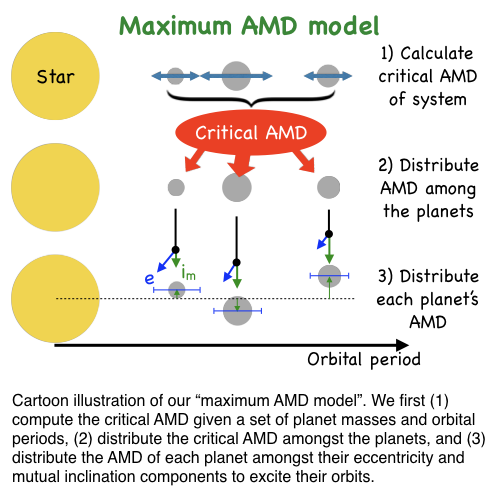
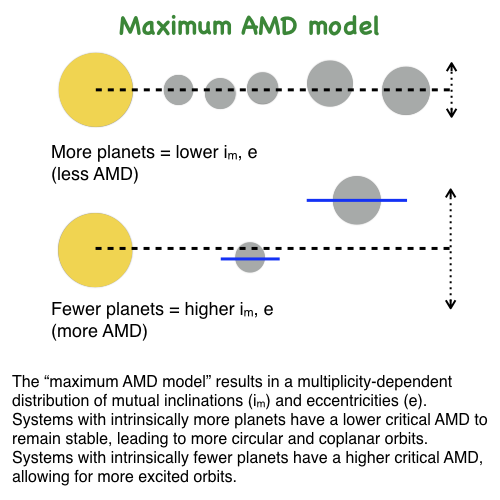
Our code for simulating planet catalogs from our state-of-the-art models is available publicly. We share simulated catalogs of both intrinsic systems and observed (under a Kepler-like mission) systems. These catalogs can be used to inform radial velocity follow-up efforts in the search for additional planet companions in systems with transiting planets, such as those discovered by the TESS mission. Our models can also be used as a point of comparison with planet formation simulations, and for future studies of planetary system architectures.
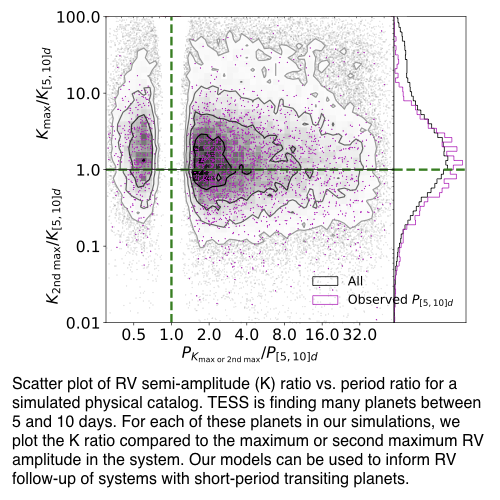
How to cite: He, M., Ford, E., and Ragozzine, D.: The Occurrence, Architectures, and Correlations of AMD-Stable Planetary Systems, Europlanet Science Congress 2020, online, 21 Sep–9 Oct 2020, EPSC2020-531, https://doi.org/10.5194/epsc2020-531, 2020.
The distribution of eccentricities of warm giant exoplanets is commonly explained through planet--planet interactions, although no physically sound argument favours the ubiquity of such interactions. No simple, generic explanation has been put forward to explain the high mean eccentricity of these planets.
In this talk, I will present a simple, plausible explanation to account for the eccentricities of warm Jupiters: migration inside a cavity in the protoplanetary disc. Such a scenario allows to excite the outer eccentric resonances, a working mechanism for higher mass planets, leading to a growth in the eccentricity while preventing the drag from non-corotating eccentric gas to damp eccentricity. This idea is tested with diverse numerical simulations, which show that the eccentricity of a Jupiter-mass planet around a Sun-like star can increase up and settle to $\sim 0.4$, a value never reached before with solely planet--disc interactions. This high eccentricity is comparable to, if not larger than, the median eccentricity of warm Saturn- to Jupiter-mass exoplanets.
I will finally discuss the effects such a scenario would have on observations, notably on the discs lifetime and the physics of inner disc dispersal.
How to cite: Debras, F., Baruteau, C., and Donati, J.-F.: Revisiting migration in a disc cavity to explain the high eccentricities of warm Jupiters, Europlanet Science Congress 2020, online, 21 Sep–9 Oct 2020, EPSC2020-678, https://doi.org/10.5194/epsc2020-678, 2020.
Are minor bodies and dust delivering volatile and/or refractory materials in exoplanetary systems?
Around ~20% of the nearest stars are found to host analogues of the main asteroid belt and the Kuiper belt. Our aim is to study the possibility of material delivery through minor bodies and dust to the planetary surfaces. To shed light on these delivery processes we extrapolate our Solar System scenarios to the exoplanetary system HR 8799. The system is known to host four giant planets and two belts of minor bodies.
We performed a set of N-body simulations to study the impact rates of minor bodies and dust on the HR 8799 planets. We find that the planets suffer impacts by objects from the inner and outer belt. We convert these to volatile and refractory delivery rates using our best estimates of the total mass contained in the belts and their volatile/refractory content. Over their lifetime, the four giant planets receive between 10-4 and 10-3 MEarth of material from both belts. This delivery leads to volatile and refractory enrichment of the planets that may be observable. Since the four giants HR 8799 e, d, c, b are located beyond the snow line (and presumably formed there), we expect them to be born volatile-rich. Therefore any future detection of refractories might imply delivery through impacts.
How to cite: Frantseva, K., Mueller, M., Pokorný, P., van der Tak, F. F. S., and ten Kate, I. L.: Enrichment of the HR 8799 planets by minor bodies and dust, Europlanet Science Congress 2020, online, 21 Sep–9 Oct 2020, EPSC2020-805, https://doi.org/10.5194/epsc2020-805, 2020.
Past, present and forthcoming space missions (e.g. Kepler/K2, TESS, CHEOPS, JWST, PLATO, ARIEL) and ground-based observational facilities (e.g. VLT, VLTI, ALMA) were, are and will be the sources of the high quality data necessary to unveil the properties of the planetary systems. Thanks to them the recent enormous increase in number of known planets gives a unique opportunity to study the processes responsible for planet formation and evolution in more detail. The observed properties of numerous planets allow for the robust constraints to be put on planet formation models. Both ground and space-based surveys have derived distributions of fundamental planetary properties like the frequency of planets in the mass-distance and radius-distance planes, the planetary mass function, the eccentricity distribution, or the planetary mass-radius relation. Now it is possible to compare the theoretical predictions with the observed properties of the planet population as a whole. The technique used for this comparison is known as the planet population synthesis [1-4]. One of the assumptions in this method is the migration rate of the planets. At the early stages of the evolution, when planets are still embedded in a gaseous disc, the tidal interactions between the disc and planets cause the planetary orbital migration. The orbital migration may play an important role in shaping stable planetary configurations. The outcome of the simulation depends strongly on the way in which the planets migrate. An understanding of this stage of the evolution will provide insight on the most frequently formed architectures, which in turn are relevant for determining the planet habitability.
There has been recently an important development in the understanding of the orbital migration of planets which are able to open a partial gap in the protoplanetary disc (e.g. [5], [6], and references therein). It has been shown that such planets migrate differently than it has been assumed till now [7]. This subject is now at the leading edge of the studies of the dynamical interactions that occur in newly formed planetary systems. Here, we are going to present our most recent results on the two super-Earths migrating in a gaseous protoplanetary disc.
[1] Mordasini, C., Alibert, Y., Benz, W. (2009), Extrasolar planet population synthesis. I. Method, formation tracks, and mass-distance distribution, A&A, 501, 1139
[2] Mordasini, C., Alibert, Y., Benz, W., Naef, D. (2009), Extrasolar planet population synthesis. II. Statisticalcomparison with observations, A&A, 501, 1139
[3] Alibert, Y., Carron, F., Fortier, A., et al. (2013), Theoretical models of planetary system formation: mass vs. semi-major axis, A&A, 558, A109
[4] Benz, W., Ida, S., Alibert, Y., Lin, D., & Mordasini, C. (2014), Planet Population Synthesis, Protostars and Planets VI, 691
[5] Robert C. M. T., Crida A., Lega E., Méheut H., Morbidelli A. (2018) Toward a new paradigm for Type II migration, A&A, 617, A98
[6] Kanagawa, K. D., Tanaka, H., & Szuszkiewicz, E, (2018), Radial migration of gap-opening planets in protoplanetary disks. I. The case of a single planet ApJ, 861, 140
[7] Duffell, P. C., Haiman, Z., MacFadyen, A. I., D’Orazio, D. J., Farris, B. D. (2014), The Migration of Gap-Opening Planets is not Locked to Viscous Disk Evolution , ApJL, 792, L10
How to cite: Cui, Z., Papaloizou, J., and Szuszkiewicz, E.: On the role of orbital migration in the early phases of the evolution of planetary systems, Europlanet Science Congress 2020, online, 21 Sep–9 Oct 2020, EPSC2020-820, https://doi.org/10.5194/epsc2020-820, 2020.
Over 4000 exoplanets have been discovered in the past 25 years, most of which orbit around low-mass stars. For the shortest period exoplanets, like Hot-Jupiter systems, star-planet tidal interactions are likely to have played a major role in the orbital architecture and rotational evolution of the planets and their host star, through stellar and planetary tidal dissipation (see e.g. Ogilvie 2014, Mathis 2019, and references therein). Moreover, stellar tidal dissipation is known to vary considerably with the mass, age, rotation, and metallicity of the star (Mathis 2015, Gallet et al. 2017, Bolmont et al. 2017). To draw a comprehensive picture of tidal dissipation in stars and giant gaseous planets, one key physical mechanisms need to be further explored: differential rotation. Recent improvements in asterosismology and spectropolarimetry have helped to establish that the convective envelope of low-mass stars is differentially rotating like in the Sun (e.g. Barnes et al. 2017, Benomar et al. 2018). Similarly, data furnished by Cassini Grand Finale and the probe Juno, showed that cylindrical differential rotation extends into the convective envelope of Saturn and Jupiter below their surface (Galanti et al. 2019, Kaspi et al. 2017, respectively), which augurs similar rotation profiles for giant gaseous exoplanets.
Nevertheless, differential rotation is rarely taken into account to compute tidal dissipation. Yet, Baruteau & Rieutord (2013) and Guenel et al. (2016a,2016b) have shown, using rotation profiles inspired by those encountered in solar-like stars and giant gaseous planets, that differential rotation can strongly affect the dynamics and dissipation properties of linear tidal waves. In particular, they pointed out that tidal waves deeply interact with zonal flows at the so-called corotation resonances, where the Doppler-shifted wave frequency vanishes, with the possibility that this interaction becomes unstable. This phenomenon that gives rise to an intense and localised energy dissipation is still poorly understood. In that context, we have developed a new local shear box that models a small patch of the convective zone of a low-mass star or a giant planet, in order to understand the complex interplay between tidal waves and zonal flows. The inclination of the box with respect to the rotation axis allows us to study the impact of cylindrical rotation profile when the box is at the pole (similar to Jupiter, Saturn and rapidly rotating stars rotation profiles, e.g. Gastine et al. 2013), and conical differential rotation profile when the box is tilted (analogous to that of the Sun and solar-type stars, e.g. Brun et al. 2017). We investigate the transmission of free linear inertial waves, within a fluid in thermal-wind balance, at corotation resonances and more broadly at critical levels that are singularities in the differential equation governing wave propagation. By the use of an invariant of energy flux, we diagnose each critical level according to the used rotation profile. Indeed, we find different regimes in which waves can be either fully transmitted, damped (as shown in the figures below) or even amplified with strong consequences for the tidal angular momentum exchanges. These different regimes of wave transmission are found both with conical and cylindrical rotation profiles, and depend on the critical level encountered, on the wave properties (direction, wavenumbers) and on the profile of the mean flow (first and second derivative). In particular, we demonstrate that a criterion analogous to the Miles-Howard theorem for the stability of gravity waves with vertical shear, is expected when using a cylindrical profile. Alongside this analytical study, we have numerically solved the leading equations for free inertial waves in a dissipative medium, where turbulent friction is taken into account thanks to a frictional damping force. We observed a good consistency between the analytical and numerical results, though some discrepancies are reported when using a non-linear mean flow profile at corotation. Based on these results, we discussed possible applications to the interiors of giant-gaseous planets and solar-like stars. Thanks to values of shear contrast given by asterosismology observations or 3D numerical simulations for solar-like stars, and to an analytical equatorial model for giant gaseous planets, we determine which regime of wave transmission is expected at each critical level in the convective envelope of these objects. It turns out that for K and G-type stars along their lifetime, and for Jupiter and Saturn at the present time, a regime where inertial waves are strongly damped is largely preferred in the convective envelope of these objects.
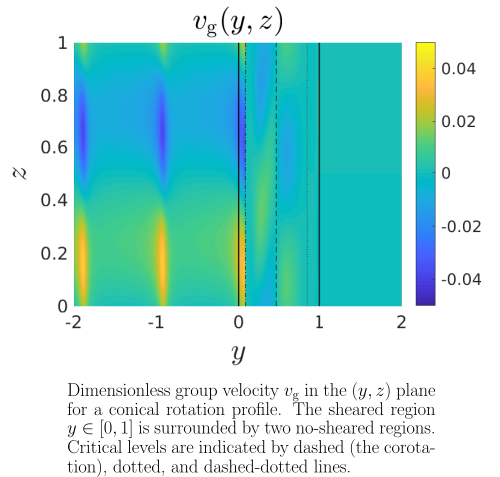
How to cite: Astoul, A., Park, J., Mathis, S., Baruteau, C., and Gallet, F.: Effect of differential rotation on tidal waves in the convective envelope of low-mass stars and giant planets, Europlanet Science Congress 2020, online, 21 Sep–9 Oct 2020, EPSC2020-907, https://doi.org/10.5194/epsc2020-907, 2020.
The external supply of gas to planetary atmospheres may be important to set their final compositions. In this talk, I will summarize recent works that quantified in an exoplanetary context, how much gas can be delivered to planets from late gas disks, which appear to be rather ubiquitous around main-sequence stars with bright planetesimal belts. This new gas component is indeed found to be present for tens and sometimes hundreds of millions of years around main-sequence stars. The gas is thought to be released from planetesimals when they collide together in their parent belt, which creates a gas disk (made of volatiles) that can viscously spread further in the system and encounter the already formed planets that can capture this gas, which will affect the primordial atmospheres of these planets. Kral et al. (2020) show that this very late accretion onto planets is very efficient and may allow capturing large quantities of carbon and oxygen (and potentially some nitrogen and hydrogen) leading to new atmospheric masses onto capturing terrestrial planets between that of the Earth's atmosphere to planets with massive atmospheres with sub-Neptune-like pressures. New secondary atmospheres with high metallicities will be created on terrestrial planets bathing in these late gas disks, resetting their primordial compositions inherited from the protoplanetary disk phase, and providing a new birth to planets that lost their atmospheres to photoevaporation or giant impacts. This volatile delivery for tens of Myr may also be favourable to the development of the first bricks of life. It will also affect the metallicity and C/O ratio of giant planets accreting late gas, which is an effect that may be observable in the close future. This very efficient accretion opens the way to a new planet detection method (for planets down to Earth masses at a few au from their stars) that I will present in this talk.
How to cite: Kral, Q.: The effect of late gas disks on the late stages of planet formation, Europlanet Science Congress 2020, online, 21 Sep–9 Oct 2020, EPSC2020-909, https://doi.org/10.5194/epsc2020-909, 2020.
Abstract
Transit observations of exoplanets, although suffering from detection and geometrical biases, indicate that there are several intra-system trends in the architecture of Planetary Systems (PS). According to one such collection of trends, exoplanets tend to be similar and ordered in their size/mass, and are evenly spaced with respect to their adjacent neighbour [1-4]. Additionally, smaller planets tend to be closely packed, while larger planets tend to have large orbital spacing. These trends are collectively referred to as ‘peas in a pod’. Given these trends, two branches of questions emerge: Are these trends astrophysical in origin or a result of detection biases? and If astrophysical, what do they imply for our understanding of exoplanets?
In this contribution, we present our analysis of the ‘peas in a pod’ trend for the PSs simulated with the Bern Model. The Bern Model is a theoretical model of planet formation and evolution [5]. The model tracks the growth of several planetary embryos (embedded in protoplanetary disk) and their subsequent formation and evolution into PSs [6]. The synthetic PSs are analysed by a computer code KOBE (Kepler Observes Bern Exoplanets) [7]. KOBE simulates transit survey of exoplanets and adds the geometrical and detection biases of Kepler.
Restricting the sample to multi-PSs, by applying the same selection cuts as [4], leads to a population of KOBE-Multi PS (KMPS). This can now be compared with the observed multi-PSs, the ‘CKS-Multis’ (CKSM) catalogue [4] The peas in a pod trend is analysed in the synthetic PSs by measuring the correlations present in the sizes, masss, spacing and packing of adjacent planets. For size and mass, the Pearson/Spearman correlation tests are performed on the radius and mass of adjacent planets. For spacing, the correlation tests are done on the period ratio of adjacent pairs of planets. For packing, the average size of a planetary pair is compared with the period ratio of these two planets.
In Fig. 1, we present a comparison of the correlations present in observations and theory. We find that size and packing correlations present in KOBE PSs are in good agreement with those found in observations. For spacing, KOBE systems show weaker correlations than seen in observations. Additionally, since the theoretical underlying population is available, we study the role of adding detection biases in producing these correlations. This is done by testing for correlations in the underlying synthetic population, simulated by Bern Model.
To sum up, our findings indicate that the Bern Model shows trends similar to the observational peas in a pod trend. In this contribution, the astrophysical origins of these trends are explored and their implications on our knowledge is suggested.
Figure 1. Comparison of correlations present in observed multi-planetary systems (CKSM) and theoretically simulated planetary systems (KMPS). The strength of correlation is measured by the Pearson Correlation coefficient R, plotted on the y-axis. The 4 panels show the correlations present in planetary size, mass, spacing and packing. Since, transit observations do not provide planetary masses, correlation in mass for CKSM is not available. Overall, we note that there are remarkable similarities and understandable differences in the theoretical and observed populations.
References
[1] Lissauer J J, Ragozzine D, Fabrycky D C, Steffen J H, Ford E B, Jenkins J M, Shporer A, Holman M J, Rowe J F, Quintana E V., Batalha N M, Borucki W J, Bryson S T, Caldwell D A, Carter J A, Ciardi D, Dunham E W, Fortney J J, Gautier, III T N, Howell S B, Koch D G, Latham D W, Marcy G W, Morehead R C and Sasselov D 2011 ARCHITECTURE AND DYNAMICS OF KEPLER ’S CANDIDATE MULTIPLE TRANSITING PLANET SYSTEMS Astrophys. J. Suppl. Ser. 197 8
[2] Ciardi D R, Fabrycky D C, Ford E B, Gautier T N, Howell S B, Lissauer J J, Ragozzine D and Rowe J F 2013 ON THE RELATIVE SIZES OF PLANETS WITHIN KEPLER MULTIPLE-CANDIDATE SYSTEMS Astrophys. J. 763 41
[3] Millholland S, Wang S and Laughlin G 2017 Kepler Multi-planet Systems Exhibit Unexpected Intra-system Uniformity in Mass and Radius Astrophys. J. 849 L33
[4] Weiss L M, Marcy G W, Petigura E A, Fulton B J, Howard A W, Winn J N, Isaacson H T, Morton T D, Hirsch L A, Sinukoff E J, Cumming A, Hebb L and Cargile P A 2018 The California- Kepler Survey. V. Peas in a Pod: Planets in a Kepler Multi-planet System Are Similar in Size and Regularly Spaced Astron. J. 155 48
[5] Emsenhuber A, Mordasini C, Burn R, Alibert Y, Benz W, and Asphaug E: NGPPS I. A&A (subm.)
[6] Emsenhuber A, Mordasini C, Burn R, Alibert Y, Benz W, and Asphaug E: NGPPS II. A&A (in prep.)
[7] Mishra L, et. al.: NGPPS - KOBE - The peas in a pod trend in the architecture of planetary systems (in prep.)
How to cite: Mishra, L., Alibert, Y., Udry, S., Leleu, A., Burn, R., Mordasini, C., and Emsenhuber, A.: New Generation Planetary Population Synthesis (NGPPS): Analysing peas in a pod trend in planetary system architecture through KOBE (Kepler Observes Bern Exoplanets), Europlanet Science Congress 2020, online, 21 Sep–9 Oct 2020, EPSC2020-912, https://doi.org/10.5194/epsc2020-912, 2020.
In the past years, astronomers have discovered many non-planetary structures in extrasolar systems such as a comet (Kiefer et al. 2014), an asteroid belt (Moro-Martín et al. 2008), an exoplanetary ring (Kenworthy & Mamajek 2015), and more recently the formation of an exomoon (Isella et al. 2019). But, although the search for exotrojans has not had success so far (e.g. Lillo-Box, J. et al. 2018), they must be as common as they are in the Solar System.
Co-orbital systems were widely studied, and there are several works on stability and the formation of these structures. However, for the size and location of the stable regions, authors usually describe their results but do not provide a way to find them without numerical simulations and, in most works, the mass ratio value range is small. In the current work, we aimed to study the structure of co-orbital stable regions for a wide range of mass ratio systems and built empirical equations to describe them. It allows estimating the size and location of co-orbital stable regions from a few system’s parameters.
In our recently published work (Liberato & Winter 2020), we have distributed thousands of massless particles in the co-orbital region of a massive secondary body adopting the planar circular restricted three-body problem. Using the N-body integrator Mercury (Chambers 1999) with the Bulirsh-Stoer integrator, we performed numerical simulations for a wide range of mass ratios (μ) for 7x105 orbital periods of the secondary body.
We divided the results into two groups, the horseshoe and tadpole stable regions. We found that the horseshoe regions upper limit is between 9.539 × 10-4< μ < 1.192 × 10-3, which correspond to a minimum angular distance from the secondary to the separatrix between 27.239° and 27.802°. We also found that the limit to exist stability in the co-orbital region is about μ = 2.3313 × 10-2. That value is much smaller than the predicted by the linear theory, but we haven’t studied the stability for mass ratio values greater than 2.785×10-2. We have fitted polynomial functions to our results to describe the stable region parameters to represent estimates of the maximum angular and radial widths of the co-orbital stable regions for any system with 9.547 × 10-5 ≤ μ ≤ 2.331 × 10-2.
References:
-Chambers J. E., 1999, Monthly Notices of the Royal Astronomical Society, 304, 793
-Isella A., Benisty M., Teague R., Bae J., Keppler M., Facchini S., Pérez L.,2019, The Astrophysical Journal, 879, L25
-Kenworthy M. A., Mamajek E. E., 2015, The Astrophysical Journal, 800, 126
-Kiefer F., Lecavelier des Etangs A., Boissier J., Vidal-Madjar A., Beust H., Lagrange A. M., Hébrard G., Ferlet R., 2014, Nature, 514, 462
-L. Liberato, O. C. Winter, The structure of the co-orbital stable regions as a function of the mass ratio, 2020, Monthly Notices of the Royal Astronomical Society, , staa1727,
-Lillo-Box, J. Barrado, D. Figueira, P. Leleu, A. Santos, N. C. Correia, A. C. M. Robutel, P. Faria, J. P. 2018, Astronomy & Astrophysics, 609, A96
-Moro-Martín A., Wyatt M. C., Malhotra R., Trilling D. E., 2008, The Solar System Beyond Neptune, p. 465
How to cite: Liberato, L. and Winter, O.: The structure of the co-orbital stable regions as a function of the mass ratio, Europlanet Science Congress 2020, online, 21 Sep–9 Oct 2020, EPSC2020-927, https://doi.org/10.5194/epsc2020-927, 2020.
We study the spin evolution of close-in planets in compact multi-planetary systems. The rotation period of these planets is often assumed to be synchronous with the orbital period due to tidal dissipation. Here we show that planet-planet perturbations can drive the spin of these planets into non-synchronous or even chaotic states. These asynchronous configurations are possible even for nearly circular orbits and will impact the habitability of these planets. We also present a very simple method to probe the spin dynamics from the orbital perturbations.
How to cite: Correia, A. C. M. and Delisle, J.-B.: Asynchronous and chaotic rotation for compact planetary systems, Europlanet Science Congress 2020, online, 21 Sep–9 Oct 2020, EPSC2020-957, https://doi.org/10.5194/epsc2020-957, 2020.
The formation of protoplanetary discs is central to planet formation because it sets its initial conditions. Planet formation may also occur while the star-and-disc system is still being formed.
In this work we perform an extensive parameter study of the formation and evolution of protostellar and protoplanetary discs that includes many key physical processes and produces a population of stars in agreement with the initial mass function.
We constrain physical quantities like mass, radius, lifetime and gravitational instabilities of protostellar and protoplanetary discs by studying their evolution from formation to dispersal.
We perform a total of 50'000 simulations using a 1D vertically-integrated viscous evolution code, studying a parameter space of final stellar masses from 0.05 to 5 Msol.
Each star-and-disc system is set up shortly after the formation of the protostar and fed by infalling material from the parent molecular cloud core. Initial conditions are chosen based on the results from the radiation hydrodynamics population synthesis of circumstellar discs by Bate (2018). We also consider a different infall prescription based on the results of Hennebelle et al. (2016) in order to assess the influence of magnetic fields on the disc formation.
We find that protoplanetary discs are very massive early in their lives. When averaged over the entire stellar population, we find ~0.3 and ~0.1 Msol for systems based on hydrodynamic or MHD initial conditions, respectively. Around stars of mass ~ 1 Msol, we find disc masses of ~0.7 and ~0.2 Msol for "hydro"/"MHD", respectively. Furthermore, the inferred total disc lifetimes are long, ~5 - 7 Myr on average. This is despite our choice of a high value of 10-2 for the background viscosity α-parameter.
In addition, we find fragmentation is common in systems based on hydrodynamic simulations, with more fragments of larger mass formed in more massive systems. In contrast, magnetic fields may suppress fragmentation completely.
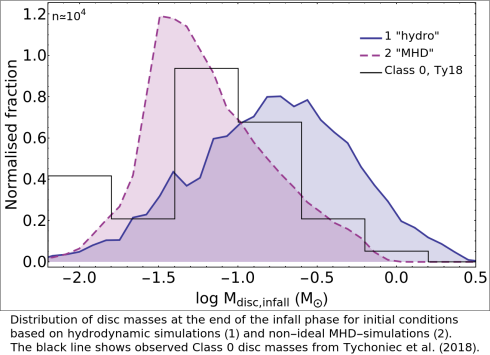
How to cite: Schib, O., Mordasini, C., and Helled, R.: The influence of infall on the properties of protoplanetary disks, Europlanet Science Congress 2020, online, 21 Sep–9 Oct 2020, EPSC2020-1025, https://doi.org/10.5194/epsc2020-1025, 2020.
Please decide on your access
Please use the buttons below to download the presentation materials or to visit the external website where the presentation is linked. Regarding the external link, please note that Copernicus Meetings cannot accept any liability for the content and the website you will visit.
Forward to presentation link
You are going to open an external link to the presentation as indicated by the authors. Copernicus Meetings cannot accept any liability for the content and the website you will visit.
We are sorry, but presentations are only available for users who registered for the conference. Thank you.

